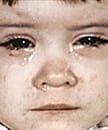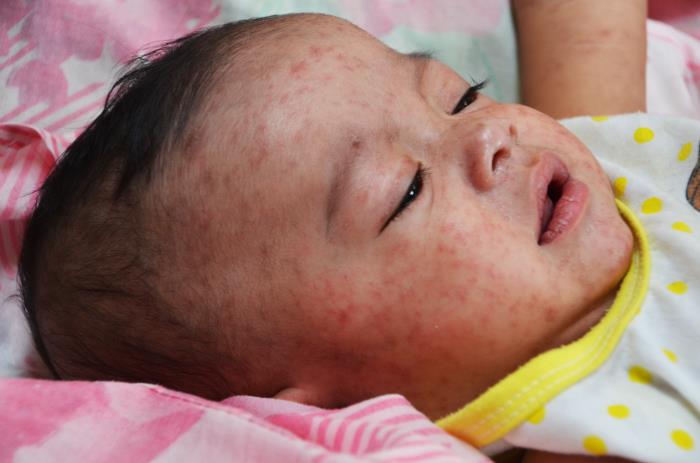[Above image: an infant who is too young to be vaccinated and infected with measles rash]
A total of 141 people in the U.S.– almost all of them in California — have caught a highly contagious case of measles since January 1, according to the Centers for Disease Control (CDC).
Measles is nothing to sneeze at.
It often comes with a runny nose, teary eyes, high fever, cough and skin rash. Most people who catch measles will recover without complications. But CDC says one in four will become so sick, they have to be hospitalized. In the California outbreak, CDC reports a slightly lower hospitalization rate of 20%. CDC has not reported any deaths or brain injury — two potential serious outcomes — related to this outbreak.
Measles was considered eliminated from the U.S. in 2000. That means while there are continuing outbreaks each year, measles is no longer constantly present in this country.
The U.S. vaccination rate for MMR (measles, mumps, rubella) remains high. It was 90% in 1995 and 91% in 2012, according to CDC data.
[button link=”https://sharylattkisson.com/the-non-measles-outbreak-thats-not-making-news/”]Related: The Non-Measles Outbreak That’s Not Making News[/button]
Foreign Sources
Why are there continuing outbreaks if most Americans are vaccinated and measles is basically eliminated in the U.S.?
The culprit, according to CDC, is measles brought from other countries into the U.S. Both vaccinated and unvaccinated people are catching it.
[quote]“The [current California-related] outbreak likely started from a traveler who became infected overseas with measles, then visited [Disneyland properties in California] while infectious. However, no source has been identified.”–CDC.[/quote]

In addition to the U.S. cases, CDC reports one case was reported from Mexico in an unvaccinated child who visited Disneyland Resort Theme Parks twice last December.
Nearly all of the 288 measles cases in the U.S. analyzed in the first half of last year were attributed to foreign importation. They came from at least 18 countries.
“Every year, measles is brought into the United States by unvaccinated travelers, Americans or foreign visitors, who get measles while they are in other countries,” reports CDC.
The current California outbreak–sourced to Disneyland in Orange County–isn’t the only one associated with theme parks. In 2014, CDC reported that an unnamed “Orlando area theme park” was believed to be a common source for an outbreak in Florida.
[box]2015 U.S. Measles Outbreaks: Jan. 1 – Feb. 13:
141 people in 17 states and Washington DC were reported to have measles.
98-California, 11-Illinois, 7-Arizona, 4-Nevada, 4-Washington, 2-Nebraska, 2-New York, 2-South Dakota, 2-Utah, 1-Colorado, 1-Washington D.C., 1-Delaware, 1-Minnesota, 1-Michigan, 1-New Jersey, 1-Oregon, 1-Pennsylvania, 1-Texas.
Source: CDC[/box]
Why do Vaccinated People Get Measles?
According to new information from the Centers for Disease Control (CDC), a majority of California patients, 55%, had either been vaccinated or had unknown vaccination status.
The rest, 45% (49 patients), were known to be unvaccinated. One in four of them were too young for shots: MMR vaccine is considered by some to be too dangerous for babies younger than age one and CDC does not recommend it. However, some doctors say vaccination is safe for younger children.
CDC says 43% (47 patients) had “unknown or undocumented vaccination status,” but did not explain further why the status was unknown or undocumented. “Undocumented” status implies the patient may have claimed vaccination, but was unable to prove it.
[quote]”Experts aren’t sure why some people who are fully vaccinated against measles still get the disease,” says CDC. “It could be that their immune systems didn’t respond as well as they should have to the vaccine.”[/quote]
Still, people who are fully vaccinated are thought to be more likely to have a milder form of measles if they do get it.
[box]By the Numbers
CDC analysis of 288 U.S. measles cases January – May of 2014 indicates:
Age:
- 18 (6%) were younger than one year old
- 48 (17%) were 1–4 years old
- 71 (25%) were 5–19 years old
- 151 (52%) were 20 years old or older
Intensity:
- Hospitalizations: 43 (15%)
- Brain injury: None (0%)
- Deaths: None (0%)
Geography:
- 18 states
- Most prevalent in: Ohio (138), California (60), and New York City (26)
Sources:
- 45 cases were “direct importations”: (40 U.S. residents returning from abroad and five foreign visitors)
- Almost half had been in the Philippines
- Imported cases were also associated with travel from other countries in the Asian Pacific, South-East Asia, Europe, the Americas including Brazil, and the Eastern Mediterranean[/box]
Reality Check
As contagious as measles is, most of the cases in the current outbreak are still isolated to California.
From 2000 to 2011, there were a total of two fatalities reported among more than 900 measles cases in the U.S.
Most people suffer no long-lasting effects from measles. If you get measles, it is unlikely you will ever get the disease again.
[button]CDC info on elimination of measles in U.S.[/button]
[button link=”https://www.cdc.gov/mmwr/preview/mmwrhtml/mm6406a5.htm?s_cid=mm6406a5_w”]CDC info on the California outbreak[/button]
[button link=”https://www.cdc.gov/mmwr/preview/mmwrhtml/mm6406a5.htm?s_cid=mm6406a5_w 2014″]CDC analysis of 2014 U.S. outbreaks of measles[/button]




I thought I read on your site that people are falling ill to the vaccine-strain measles. I cannot find it anymore. I would be most grateful if you could repost that information or include a link.